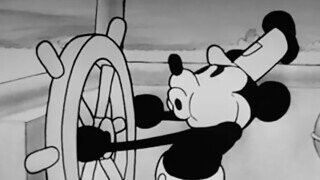The Greatest Unsanctioned Uses of Mickey Mouse

Along with numerous discarded Christmas trees and even more numerous hazy, headachey regrets, New Year’s Day also brings with it a special treat: a whole slew of intellectual properties enter the public domain.
While this happens every year, 2024 is a big one, because this is the year when Mickey Mouse finally slips away from Disney’s tight, four-fingered legal fist — or, at least, the old-timey Steamboat Willie version of Mickey, everybody’s favorite cartoon mouse/repugnant blackface substitute.
Don't Miss
Yes, after decades of delays and well-funded legal fuckery, Mickey Mouse will soon be in the public domain, no doubt ushering in a golden age of lawful ironic T-shirts and half-assed edgelord slasher movies. But prior to this moment in history, a number of brave souls still employed the image of Mickey Mouse in some litigiously-risky, wholly unauthorized projects, some of the most notable examples of which include…
An Army of Evil Mickeys Bombed Japan in a 1934 Cartoon
A 1934 Japanese cartoon found Mickey Mouse riding some kind of demonic bat creature (with a face that also resembles Mickey Mouse) attacking an island full of innocent characters from Japanese folklore. Mickey and his army of Mickey clones are obviously a stand-in for America as a whole, which is possibly why the story is set in 1936, due to the “expiration of a naval treaty between the United States and Japan on that date.”
It’s hands-down the greatest movie in which Mickey Mouse plays a deranged, fanged monster, other than the one that Disney themselves made.
Mickey Is the Star of a Historical Comic Set in a Concentration Camp
In the early 1940s, cartoonist Horst Rosenthal created a 12-page comic documenting his experiences in the Vichy concentration camp, Gurs, where the government, as part of their collaboration with the Nazis, sent “Jews of any nationality other than French” as well as “undesirables” that included “several artists, writers and musicians.” The protagonist of this tragic parable? Mickey Mouse.
Mickey au Camp de Gurs, the story of the Disney icon being sent to a literal concentration camp, wasn’t published until 2014, but is now considered one of the “earliest surviving examples of a comic from the Holocaust.” Rosenthal died in Auschwitz in 1942.
Mickey Became a Grizzled Jerk in the Pages of ‘Mad Magazine’
Issue #19 of Mad Magazine, way back in 1955, took aim at the entire Disney brand with “Mickey Rodent,” a comic by Will Elder and Harvey Kurtzman that portrayed Mickey as a bitter maniac with a five o’clock shadow. He ends up imprisoning Donald Duck — er, make that Darnold Duck — after stealing his clothes, purely as a punishment for getting too much attention.
This unrelenting, meta approach to lampooning Mickey Mouse anticipated modern takes, such as the bloodthirsty Disney CEO in South Park.
That Time Mickey Mouse Got Shot by the Viet Cong
A little more than a decade after appearing in Mad, Mickey died in Vietnam. The short animated film Mickey Mouse in Vietnam premiered at the 1968 Angry Arts Festival, an event organized by anti-war activists. Throughout the course of its one-minute running time, the film chronicles how Mickey enlists in the U.S. Army, travels by boat to Vietnam and promptly gets shot in the head.
The film’s co-creator, graphic designer Milton Glaser, later revealed that there was a rumor that Disney briefly considered suing the filmmakers, but ultimately opted not to out of fears of generating bad publicity.
The Only Comic in Which Mickey Goes Down on Minnie
Perhaps the most famous work of forbidden Mickey art is 1971’s Air Pirates Funnies, the underground comic-book collection featuring a story in which Mickey casually drops f-bombs, smuggles drugs and performs oral sex on Minnie Mouse, which is shocking, but still somehow less shocking than the official Mickey Mouse comic in which Mickey and Goofy peddle amphetamines to African villagers.

Artist Dan O’Neill actually wanted Disney to sue him over the comic. When the company didn’t bite, he had copies of Air Pirates Funnies “smuggled” into a Disney board meeting by “the gay son of the chairman of Disney's board of directors.” It worked. Disney eventually filed a lawsuit, alleging “copyright infringement, trademark infringement, unfair competition, intentional interference with business and trade disparagement through the wrongful use of its characters.”
Despite the fact that Pirates was clearly a work of parody, not meant to be confused with a genuine Disney product, after fighting for eight years, O’Neill lost (the Supreme Court refused to take the case). To “stay out of prison,” he had to agree to never draw Mickey again. “If I draw a picture of Mickey Mouse, I owe Walt Disney a $190,000 fine, $10,000 more for legal fees and a year in prison,” O’Neill said in a recent interview.
Maybe keep that in mind when we all get legal access to Mickey’s likeness in a few days.
You (yes, you) should follow JM on Twitter (if it still exists by the time you’re reading this).